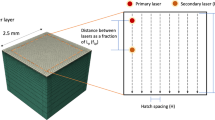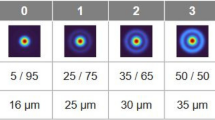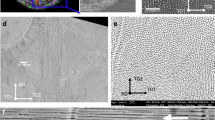Abstract
The formation of undesirable microstructures and defects hinders the widespread use of additive manufacturing, e.g., the formation of columnar grains in Ti–6Al–4 V leads to undesirable anisotropic mechanical properties. Here, we investigate the application of a novel synchronized circular laser array in the powder bed fusion technique to alter the microstructure of printed parts toward the preferable equiaxed grains. This feat is not achievable with the single laser powder bed fusion technique for Ti–6Al–4 V alloy. The temporal temperature distributions for different process parameters (laser power, scanning speed, and internal distance between lasers in the array) were obtained by an anisotropic heat transfer model, and the Hunt criterion was employed to construct the solidification map. The results revealed that a degree of overlap between lasers is recommended to form a coherent melt pool, avoid degeneracy in surface quality, and maintain adequate resolution for all processing windows. However, laser overlap is not required for low scanning speed and high power scenarios. Finally, microstructure prediction shows that 45% of printed track includes equiaxed grains at a high power regime (500 W). However, the volume fraction of the equiaxed microstructure is reduced by decreasing laser power.








Similar content being viewed by others
Availability of data and materials
The datasets used or analyzed during the current study are partially available from the corresponding author upon reasonable request.
Code availability
The code is partially available from the corresponding author on reasonable request.
References
Gaikwad AM, Steingart DA, Nga Ng T et al (2013) A flexible high potential printed battery for powering printed electronics. Appl Phys Lett. https://doi.org/10.1063/1.4810974
Ready S, Endicott F, Whiting GL et al (2013) 3D Printed Electronics
Kokkinis D, Schaffner M, Studart AR (2015) Multimaterial magnetically assisted 3D printing of composite materials. Nat Commun. https://doi.org/10.1038/ncomms9643
Babuska TF, Krick BA, Susan DF, Kustas AB (2021) Comparison of powder bed fusion and directed energy deposition for tailoring mechanical properties of traditionally brittle alloys. Manuf Lett 28:30–34. https://doi.org/10.1016/j.mfglet.2021.02.003
Bandyopadhyay A, Heer B (2018) Additive manufacturing of multi-material structures. Mater Sci Eng R Rep 129:1–16
Wen S, Liu Y, Zhou Y et al (2021) Effect of Ni content on the transformation behavior and mechanical property of NiTi shape memory alloys fabricated by laser powder bed fusion. Opt Laser Technol. https://doi.org/10.1016/j.optlastec.2020.106653
Huang S, Sing SL, de Looze G et al (2020) Laser powder bed fusion of titanium-tantalum alloys: compositions and designs for biomedical applications. J Mech Behav Biomed Mater. https://doi.org/10.1016/j.jmbbm.2020.103775
Bian L, Thompson SM, Shamsaei N (2015) Mechanical properties and microstructural features of direct laser-deposited Ti-6Al-4V. JOM 67:629–638
Cao S, Chen Z, Lim CVS et al (2017) Defect, microstructure, and mechanical property of Ti-6Al-4V alloy fabricated by high-power selective laser melting. JOM 69:2684–2692
Shamsaei N, Yadollahi A, Bian L, Thompson SM (2015) An overview of direct laser deposition for additive manufacturing; Part II: mechanical behavior, process parameter optimization and control. Addit Manuf 8:12–35
Heeling T, Wegener K (2016) Computational investigation of synchronized multibeam strategies for the selective laser melting process. In: Physics Procedia. Elsevier B.V., 899–908
Sanchez S, Hyde CJ, Ashcroft IA et al (2021) Multi-laser scan strategies for enhancing creep performance in LPBF. Addit Manuf. https://doi.org/10.1016/j.addma.2021.101948
Gerstgrasser M, Cloots M, Stirnimann J, Wegener K (2021) Residual stress reduction of LPBF-processed CM247LC samples via multi laser beam strategies. J Adv Manuf Technol 117:2093–2103. https://doi.org/10.1007/s00170-021-07083-6
Chen C, Xiao Z, Zhu H, Zeng X (2020) Distribution and evolution of thermal stress during multi-laser powder bed fusion of Ti-6Al-4 V alloy. J Mater Process Technol. https://doi.org/10.1016/j.jmatprotec.2020.116726
Masoomi M, Thompson SM, Shamsaei N (2017) Laser powder bed fusion of Ti-6Al-4V parts: thermal modeling and mechanical implications. Int J Mach Tools Manuf 118–119:73–90. https://doi.org/10.1016/j.ijmachtools.2017.04.007
Abe F, Osakada K, Shiomi K, Uematsu K, Matsumoto M (2001) The manufacturing of hard tools from metallic powders by selective laser melting. J Mater Process Technol 111:210
Zhang C, Zhu H, Hu Z et al (2019) A comparative study on single-laser and multi-laser selective laser melting AlSi10Mg: defects, microstructure and mechanical properties. Mater Sci Eng, A 746:416–423. https://doi.org/10.1016/j.msea.2019.01.024
Wei K, Li F, Huang G et al (2021) Multi-laser powder bed fusion of Ti–6Al–4V alloy: defect, microstructure, and mechanical property of overlap region. Mater Sci Eng, A. https://doi.org/10.1016/j.msea.2020.140644
Slodczyk M, Ilin A, Kiedrowski T, Ploshikhin V (2019) Influence of multi-spot exposure of powder bed on melt pool stability in selective laser melting. https://doi.org/10.1117/122508210 10909:18–25. https://doi.org/10.1117/12.2508210
Slodczyk M, Ilin A, Kiedrowski T et al (2021) Spatter reduction by multi-beam illumination in laser powder-bed fusion. Mater Des 212:110206. https://doi.org/10.1016/J.MATDES.2021.110206
Evans R, Gockel J (2021) Modeling the effects of coordinated multi-beam additive manufacturing. J Adv Manuf Technol 115:1075–1087. https://doi.org/10.1007/s00170-021-07279-w
Alsaddah M, Khan A, Groom K, Mumtaz K (2022) Diode area melting of Ti6Al4V using 808 nm laser sources and variable multi-beam profiles. Mater Des 215:110518. https://doi.org/10.1016/J.MATDES.2022.110518
Xie Z, Jiang W, Wang C, Wu X (2021) Bayesian inverse uncertainty quantification of a MOOSE-based melt pool model for additive manufacturing using experimental data
Kamara AM, Wang W, Marimuthu S, Li L (2011) Modelling of the melt pool geometry in the laser deposition of nickel alloys using the anisotropic enhanced thermal conductivity approach: 225:87–99. https://doi.org/10.1177/09544054JEM2129
Yang J, Sun S, Brandt M, Yan W (2010) Experimental investigation and 3D finite element prediction of the heat affected zone during laser assisted machining of Ti6Al4V alloy. J Mater Process Technol 210:2215–2222. https://doi.org/10.1016/J.JMATPROTEC.2010.08.007
Yin J, Peng G, Chen C et al (2018) Thermal behavior and grain growth orientation during selective laser melting of Ti-6Al-4V alloy. J Mater Process Technol 260:57–65. https://doi.org/10.1016/J.JMATPROTEC.2018.04.035
Zhang Z, Huang Y, Rani Kasinathan A et al (2019) 3-Dimensional heat transfer modeling for laser powder-bed fusion additive manufacturing with volumetric heat sources based on varied thermal conductivity and absorptivity. Opt Laser Technol 109:297–312. https://doi.org/10.1016/J.OPTLASTEC.2018.08.012
Patel S, Vlasea M (2020) Melting modes in laser powder bed fusion. Materialia (Oxf) 9:100591. https://doi.org/10.1016/J.MTLA.2020.100591
TOULOUKIAN, S. Y, (1970) Thermal conductivity, nonmetallic solids. Thermophys Properties of Matter 2:183–193
Unni AK, Vasudevan M (2021) Determination of heat source model for simulating full penetration laser welding of 316 LN stainless steel by computational fluid dynamics. Mater Today Proc 45:4465–4471. https://doi.org/10.1016/J.MATPR.2020.12.842
Kobryn PA, Semiatin SL (2003) Microstructure and texture evolution during solidification processing of Ti–6Al–4V. J Mater Process Technol 135:330–339. https://doi.org/10.1016/S0924-0136(02)00865-8
Acknowledgements
The support of Wright State University is gratefully acknowledged, and the authors extend their special thanks to Dr. Mikhail Vorontsov for the initial discussions.
Funding
The Ohio Super Computing (OSC) computational grant, Grant No. ECS- PWSU0463.
Author information
Authors and Affiliations
Corresponding author
Ethics declarations
Ethics approval
Not applicable.
Consent to participate
Not applicable.
Consent for publication
Written informed consent for publication was obtained from all participants.
Conflicts of interest
The authors declare no competing interests.
Additional information
Publisher's Note
Springer Nature remains neutral with regard to jurisdictional claims in published maps and institutional affiliations.
Supplementary Information
Below is the link to the electronic supplementary material.
Rights and permissions
Springer Nature or its licensor holds exclusive rights to this article under a publishing agreement with the author(s) or other rightsholder(s); author self-archiving of the accepted manuscript version of this article is solely governed by the terms of such publishing agreement and applicable law.
About this article
Cite this article
Attariani, H., Petitjean, S.R. & Dousti, M. A digital twin of synchronized circular laser array for powder bed fusion additive manufacturing. Int J Adv Manuf Technol 123, 1433–1440 (2022). https://doi.org/10.1007/s00170-022-10223-1
Received:
Accepted:
Published:
Issue Date:
DOI: https://doi.org/10.1007/s00170-022-10223-1




